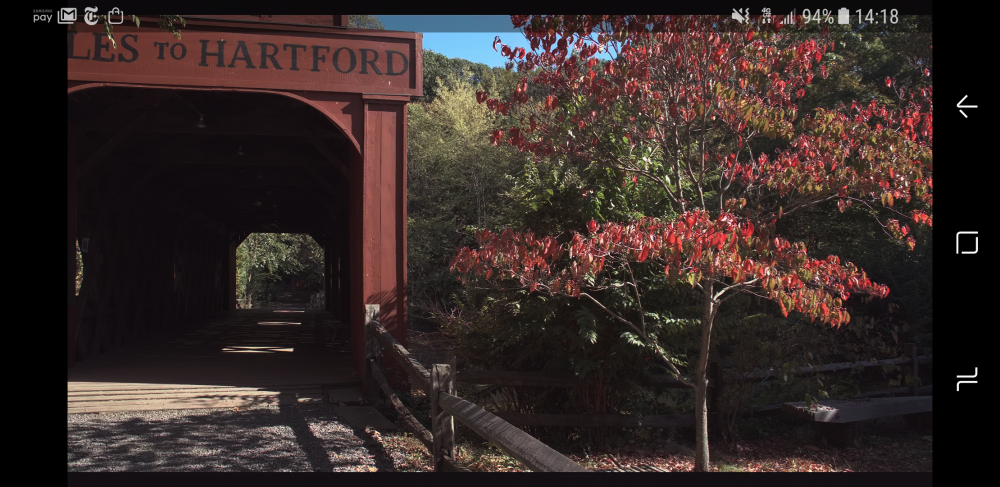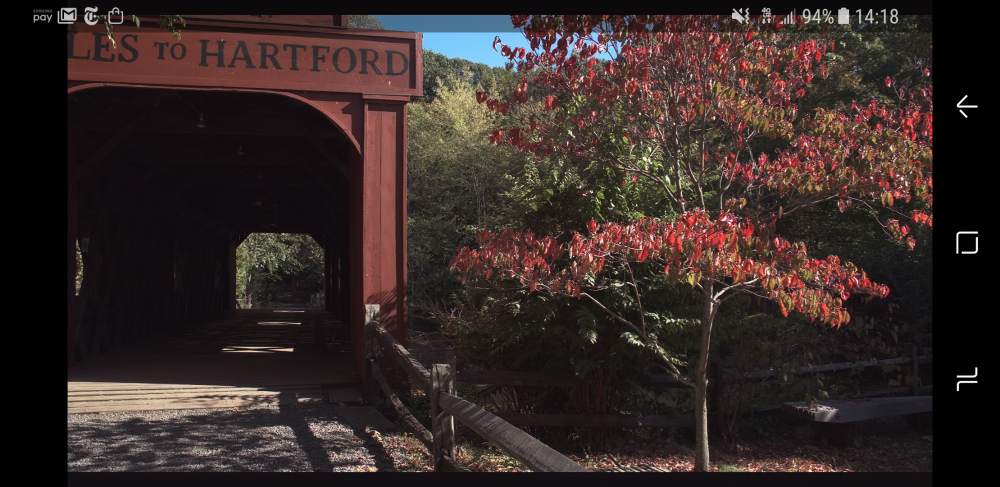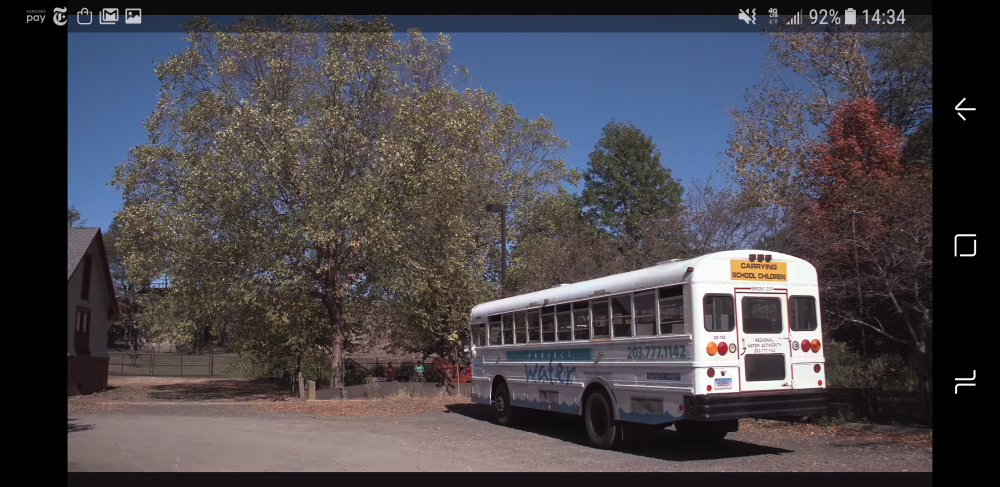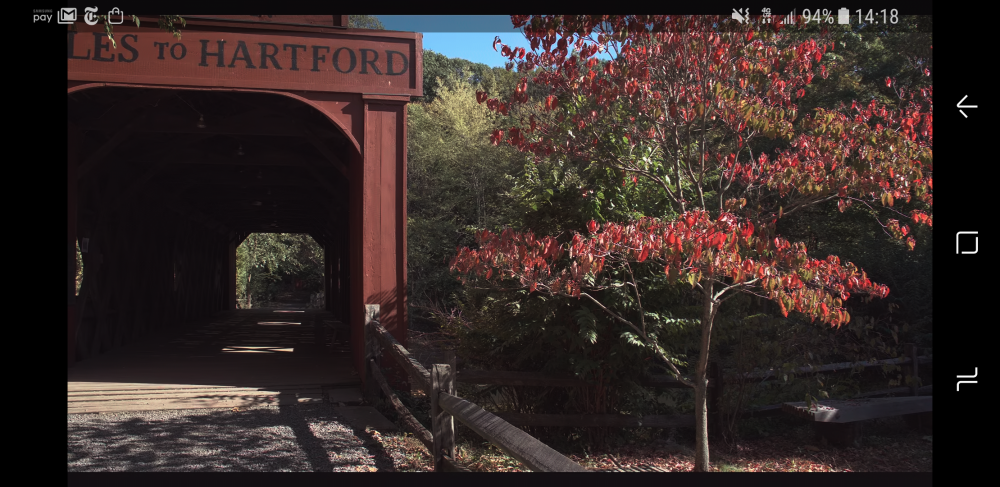
markr041
Members-
Posts
892 -
Joined
-
Last visited
Content Type
Profiles
Forums
Articles
Everything posted by markr041
-
Here is what the Z camera E1 delivers (with sat adjustment only) in dim light (Nocticron at F2):
-
Ok. I have the camera. So, let's get real :). First, at the firmware .23 that comes with the camera, half of the features do not work and autofocus does not work right. With the October update (.30), the focus now works - push to focus. You can set shutter speed, aperture, and ISO - you can set ISO to Auto and set aperture and shutter speed manually, for example. There are many tweaks for picture, including NR and sharpness. Second, the complaints about shadow noise may also be due to old firmware, since with the new firmware you can adjust noise reduction. In any case, the sensor is exactly the same as the one in the Panasonic GH4. So, performance should be similar (not identical, could be better given a newer processor and how it's tuned). So, how about a 4K30P comparison of the GH4 and the Z Camera E1 - same scene, same lens, same shutter and aperture? This is actually with the old E1 firmware. Leica Nocticron f1.2 lens (yes, a $1500 lens on a $199 camera) on both. Here it is. Same scene at F2 and at F5.6 (and ISO 800 for that scene). The cameras are in the same order for each lens/ISO setting. Which is which? which do you like better? Which has more noise? Which is more accurate? One camera's color is too orange (only I know the actual colors). WB was auto. No color correction in post. Default settings for the scenes.
-
The latest firmware update was October. Your inference is wrong. Most of the reviewers on the Amazon and BH web sites either do not understand how to use the camera or are using much earlier firmware. There have been many firmware updates since the camera became available. It would be nice to have someone here test it, if they think it useful.
-
I am trying to be helpful. Your picture conclusively showed you were not watching the video in HDR - it was what an HDR video looks like when not watched in HDR. I see it in HDR, my colleague does on his Samsung TV - and can reproduce what you see when HDR viewing is manually turned off on his TV. This is exactly his report: "At first the HDR video was very disappointing. The SDR looked better. Then I went looking in the Samsung TV menu. There is an ON/OFF for HDR. It was off. I turned it on and the HDR video was much better." The full information about the YouTube app on LG TVs is: the latest YouTube app in the operating system of all LG TVs does not appropriately play HDR10 videos, but does ok with Dolby Vision and HLG. My video metadata indicates the video if HDR10. Maybe that's the problem, maybe not. But there is a problem on your TV viewing my video, and not on my player or on a Samsung HDR TV. I am grateful you took the care to play the video and supply the pictures of what you were seeing. It is very helpful. I am not blaming anyone, just trying to figure out what is going on. I am also concerned that you or someone else would conclude that the video is washed out with no blacks, when it is not. You are not an expert on TVs or HDR and neither am I, but there is something wrong and it is not the video I am reasonably confident (I am fine if proved wrong, since the video can be easily changed). This thread is about YouTube HDR; this experience shows that there are still problems with the YouTube HDR ecosystem.
-
Sorry to interrupt, but my colleague with a Samsung HDR TV, which has a YouTube app that actually displays HDR videos reports that my HDR video looks fine, and is clearly HDR - it looks luminously realistic, not washed out (and not oversaturated). He also had to also manually set his TV to HDR mode, otherwise the picture looked washed out. Another colleague, expert in TVs, reports that the latest YouTube app for LG TVs does not display HDR. And yes, my video was shot in 10bit and rendered in 10bit, from Slog Sgamut.
-
Thanks, I take your point but And then someone posted a video here comparing the Yi to the GoPro... I do perhaps over-react because there is such a focus on GoPro from their early domination, that many just will not look around at what is happening, which is that GoPro is no longer at the frontier and is way overpriced.
-
I do not mean you took a bad shot or its too small, I mean it shows that you are not seeing HDR. Just look at the colors compared to my screenshot. Mine is HDR, yours is not - it shows what an HDR video looks like when viewed SDR. That's the point - you are not seeing the video in HDR. The writing just says it is an HDr video (which is just what the metadata say); it does not say that you are viewing it in HDR mode.
-
No. Why act as if the only action cam upgrade is a new model GoPro? I agree that the IS is good, but it's still not working in 4K 60P, it still degrades the IQ and it is nowhere near as effective as a gimbal. 60P is essential for action. The GoPro 6 image quality ("color science") is inferior to that of the Yi 4K+, which also shoot 4K 60P, at up to 200 Mbps. It has better audio too. And it is half the price. Google dropped GoPros in favor of Yi's for its 360 camera array.
-
I am waiting for a report from a colleague who has a Samsung USD tv that I know has a YouTube app that plays HDR correctly. If he has an issue, then I am happy to look more into this. In the meantime, your screenshot does look much worse than mine. So something is not right.
-
Is your TV in HDR mode? The symbol just means Youtube is playing the HDR version, it says nothing about whether the TV is in HDR mode. If I did not view the video myself in all its HDR glory I would think there is something wrong with the video, but I can and I don't. Again, you are seeing an HDR video in SDR, for whatever reason.
-
Just to clarify why there is so much confusion: 1. If you watch the HDR video on an SDR TV using the YouTube app, you will see the HDR *converted* to SDR. It will look ok, nothing special. 2. If you watch the original HDR video *unconverted* in the YouTube app but the viewing device is SDR or not in HDR mode, it will look pale, just like what the jonpais screenshots looked like. It is like viewing a log file - and you get complaints the picture looks washed out. YouTube has to know that you have an HDR-capable viewer so it shows the HDR version unconverted and the TV or phone or whatever also has to be in HDR mode.
-
Thanks for posting this. That is exactly what the video looks like if you are NOT seeing the video in HDR. See my screenshots of HDR in HDR on a player that works (without the brightness captured, of course). Again, you are seeing the original HDR video, but in SDR unconverted. YouTube is indeed showing you the HDR version, but your TV is not in HDR mode. Your viewer is not working right. Can you force your TV into HDR mode? Same frustrations.
-
Thanks for the report. It looks fine (more than fine) on my Samsung S8 in HDR - full contrast plus blacks and clearly higher DR (see below). The scopes in Resolve show full range in HDR. And Youtube's conversion from the HDR to SDR looks fine, with blacks - surely that would have been mucked up too if the HDR had no blacks, since they just use a standard template? Who knows what is going on. This is the same thing that happened a year ago, with viewers reporting odd stuff, and the end result then was that there was nothing wrong with the HDR video I posted. It was all screwball YouTube viewer (hardware not person!) behavior. But who knows. I am perfectly happy to look into this, if I could believe it (I have no doubt you know what you are doing). Anyone else seeing this in HDR? I have attached a screenshot of the HDR video viewed in HDR on my Galaxy S8 showing the blacks are fine. This is definitely HDR, and it is definitely perfectly fine. Back to the chaos.
-
And a night test:
-
This video asks the wrong question (still well done). The question should be: Should I upgrade by buying a GoPro? The answer is likely 'no', if you want 4K 60P consider the Yi 4K+, at half the price of the GoPro 6. See the thread on that here, with actual video examples.
-
Excellent. Thanks. Having that flag is really useful to confirm what one is seeing.
-
Shooting HDR Video Update About a year ago I relayed my experience shooting HDR with my GH4 + Atomos Shogun, which gave me (V) log-gamma, 10bit 422 4K 30P, 12-stops DR video suitable for HDR. DaVinci Resolve was used to create an HDR video. I created and uploaded an HDR video for YouTube. The video was viewed 4.9 thousand times. The biggest problem was viewing the video in HDR, and there was much confusion when people played the YouTube HDR video as to whether in fact YouTube was actually playing the HDR version - YouTube automatically plays its SDR version unless it detects the right viewer. Some thought by merely setting their TV to play in HDR that would automatically make YouTube play the HDR version. That was wrong, and there were comments from people viewing in HDR an SDR video. They were not impressed, but they actually did not see HDR or even SDR properly viewed. Chaos. So, what's happened since then? Having upgraded to the Sony FS700R so I can now shoot 4K DCI 60P 12bit RAW 422 video with 14 stops of dynamic range, I was ready to explore HDR again: 1. Good news: The free version of DaVinci Resolve is now a full-featured editor, and it is actually easy to use for normal editing stuff. In addition, its color management makes it easy to produce SDR or HDR videos from log-gamma videos or RAW (or HLG). You tell it the input is Slog/Sgamut or RAW and the output and time line are ST 2084 for HDR or REC709 gamma 2.4 for SDR. Easy. I used the RGB parade to check white balance and to keep the dynamic range within the limits of SDR or HDR (the scopes show clearly how much more DR you get in HDR). 2. Good news: The free version of Resolve adds the appropriate metadata for HDR that YouTube uses to detect the video is in fact HDR. YouTube , not just DaVinci, makes this claim. Resolve is the only editor to do so. 3. No improvement: One still has to make, in the free version, a DNxHR HQX version to get a 10bit 422 HDR video. It has a ridiculously high bitrate, so a 2.5 minute 4K 60P video takes up 37 gigabytes! And I cannot even play it on my i7, 7th generation computer with Nvidia 1050Ti graphics card. The non-free version of Resolve gives better options (it is only $299 now, so that may be a good buy given that Resolve really obviates the need for any other editor). 4. Good news: Before, when I uploaded my HDR video, I was never sure YouTube had detected it was HDR. Now YouTube tells you it's HDR immediately (if it is). So, it is easier and cheaper to make an HDR video if you have the camera equipment to do so - that would include GH5 owners, if they shoot UHD 30P 422 10bit in Vlog or HLG, or GH5 + Shogun Inferno to get UHD 60P 422 10bit (almost as good as what I got!). I would still recommend Vlog over HLG to get better dynamic range and to future proof against new HDR standards. 5. Good news: The standard YouTube app will play HDR videos on some cell phones automatically. These phones are the Pixel, Samsung Galaxy S8, Samsung Note 8, Xperia XZ Premium and LG V30. And I have an S8! Now, I can actually view my HDR videos easily in HDR on my cell phone. Now, it ain't 10bit, and likely not REC2020 all the way, or have 14 stops of DR. But the difference is still incredible. The white bus in sunshine in the video below, viewed in HDR, is stunning. What else plays YouTube HDR video in HDR? The YouTube app on Samsung UHD TV's for sure. But Sony TV's? LG TV's? Still have to use Chromecast Ultra as an attachment? Seems like still confusion. And how does one play an HDR video directly (insert USB stick into the TV and use its player) without YouTube on an UHD HDR TV? What codecs will play? Does one need to convert to HEVC? Anyone know? OK, here is the new HDR test video - 60P 4K: If you cannot view the video in HDR, you will see YouTube's conversion from HDR to SDR.
-
I created a 4K 60P HDR video using the FS700R+Shogun Inferno combo. If you do not have a device that can view YouTube HDR videos in HDR, you will see this in SDR, converted from HDR to SDR by YouTube.
-
I agree the lens is not a parfocal design. The points were, and you do not disagree, that no Panasonic camera is capable of zooming while shooting given available zooms by any standards of what constitutes constant focus, and Panasonic cameras including the GH5 have inadequate AF for shooting action. The post was not to tout a particular lens, it was an example of use of the A6500 with a power zoom. Of course the 18-105mm lens is not strictly parfocal and not useful for shooting football from the upper deck (I in fact wanted to say near parfocal). But it did the job here, as shown. A video trumps words - you saw the video, did you notice focus loss while zooming ? No you did not. In no case was there a distracting loss of focus despite zooming and subjects moving. Nor was there a need for a wider lens or a longer lens. It suited what it was used for in this case. And the point was this was a case in which no Panasonic mirrorless camera could be nearly as effective. A Panasonic PZ lens completely loses focus, sometimes never getting it back. For Sony, there is the additional choice of the amazingly expensive PZ electronically parfocal 18-110 lens that you mentioned or the 18-200mm power zoom (which does not have constant aperture, but does also exhibit minimal loss of focus while zooming). There are no such alternatives for the GH5. I have used all three, and have zoomed while shooting with all three with almost no perceptible focus loss problems. And now there are the parfocal Fjinon zoom lens for e-mount APS-C. Nothing for MFT. The GH5 has lots of good and unique features, shooting action is its weaknesses. I merely provided actual evidence that the A6500 can do a job that a GH5 could not.
-
Here's a video (not typical of those usually posted here) that could NOT be shot with the GH5, at all - AF and vari-speed power parfocal zoom were essential to capture the unpredictable and constantly moving subjects, which are the hallmark of the event. No Panasonic has sufficient AF capability to quickly lock on to subjects and maintain focus, and no Panasonic zoom lenses are both powered and parfocal (I have a very complete set of Panasonic mirrorless cameras and lenses). Zooming while shooting is, again, essential for sports or any moving action, and zooms must be smooth and not lose focus. The PDAF of the A6500 is very effective. Now, I would have loved to have 4K 60P... The lens: the Sony 18-105mm G.
-
More Standard, straight from the camera colors:
-
The colors in both videos are Standard, sooc. Only exposure, contrast altered in post.





